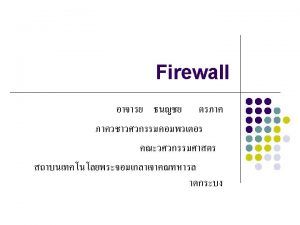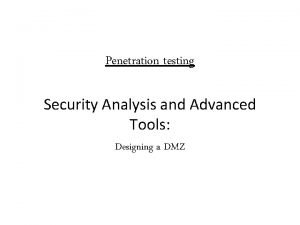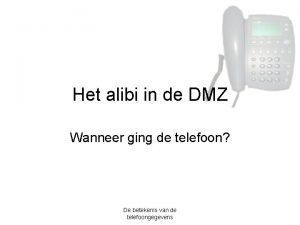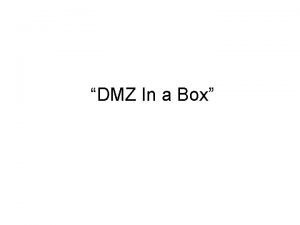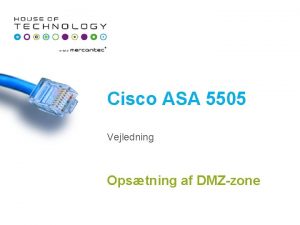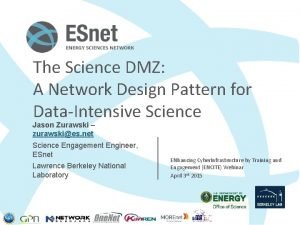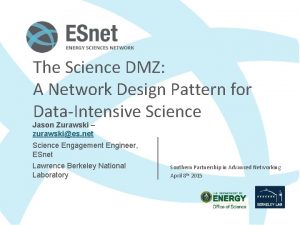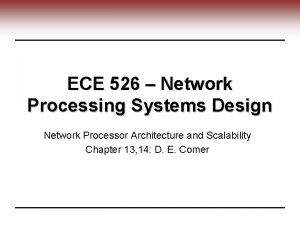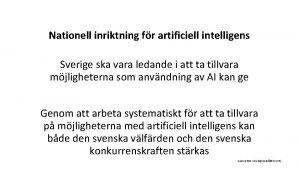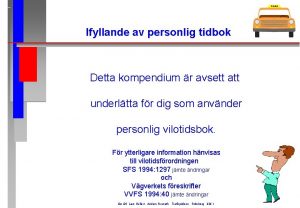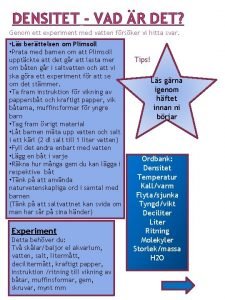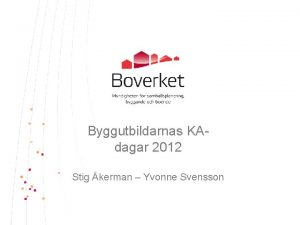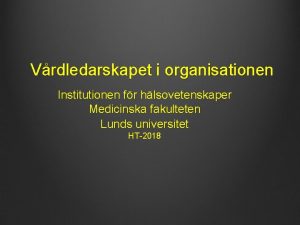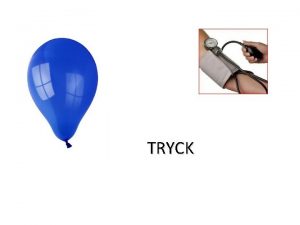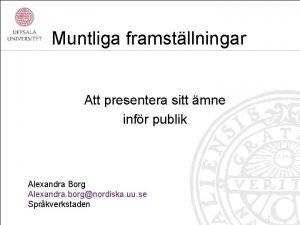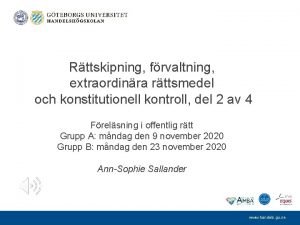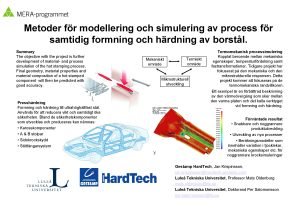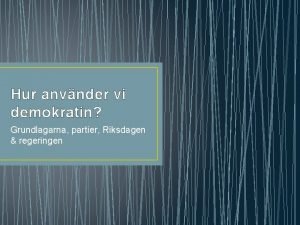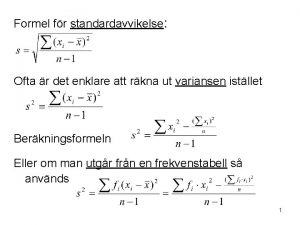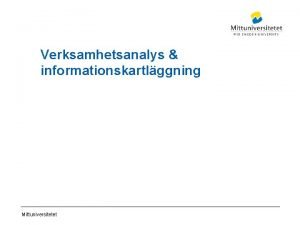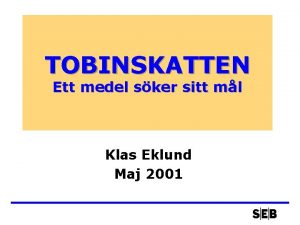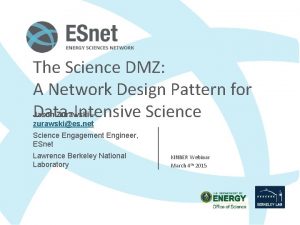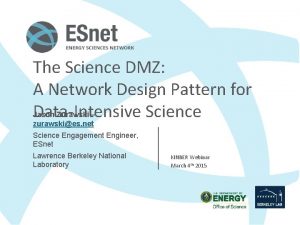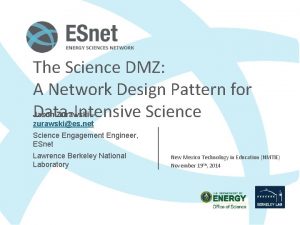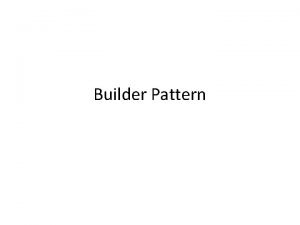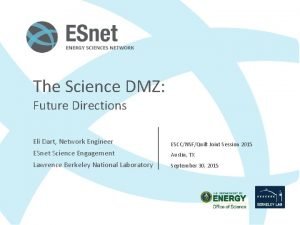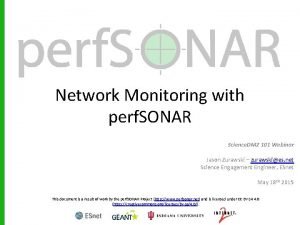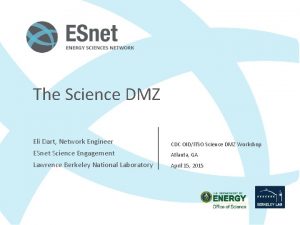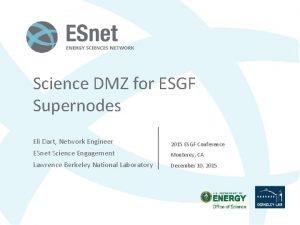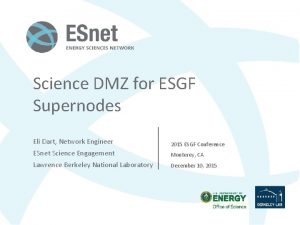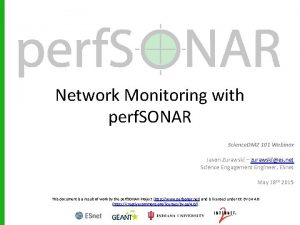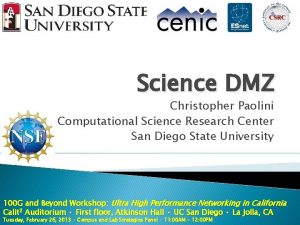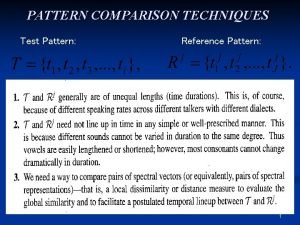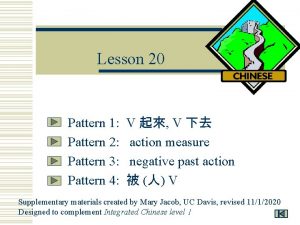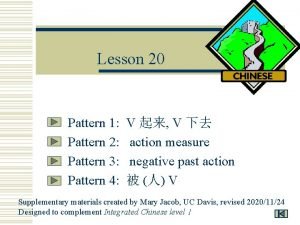The Science DMZ A Network Design Pattern for



















































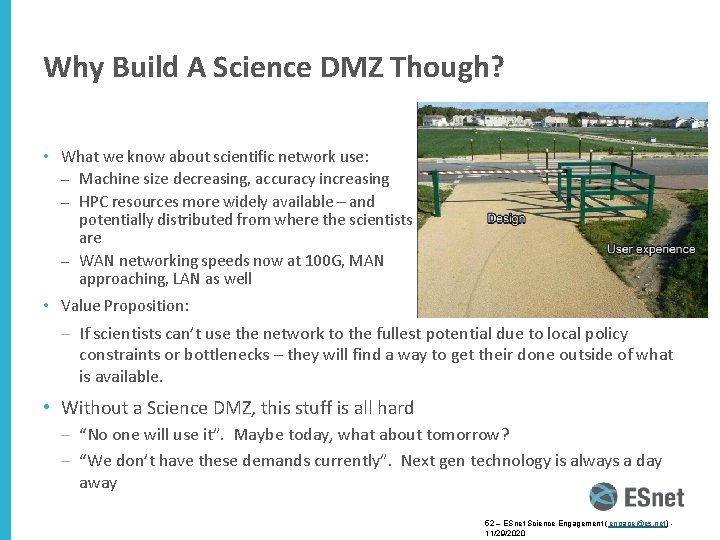

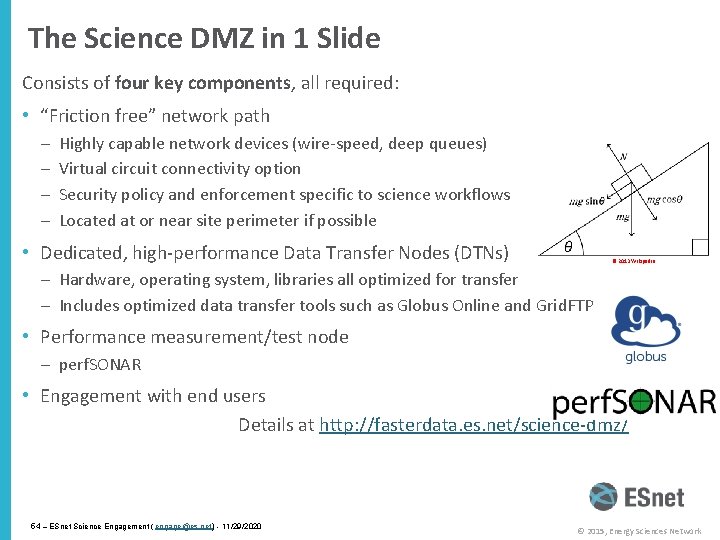
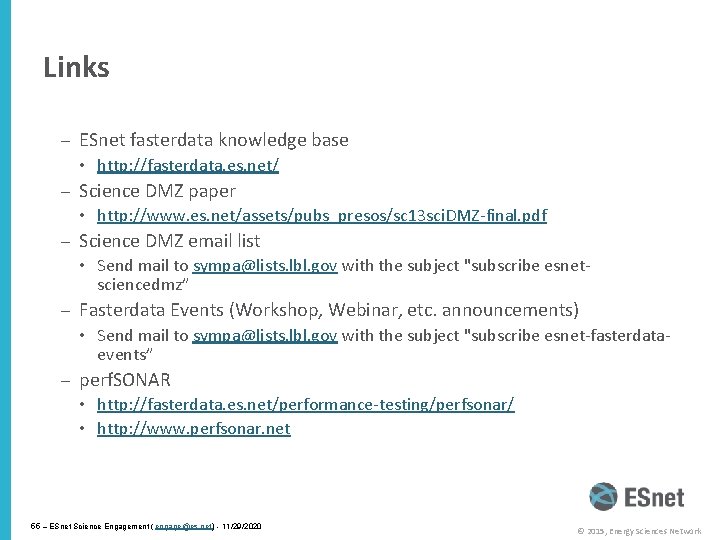
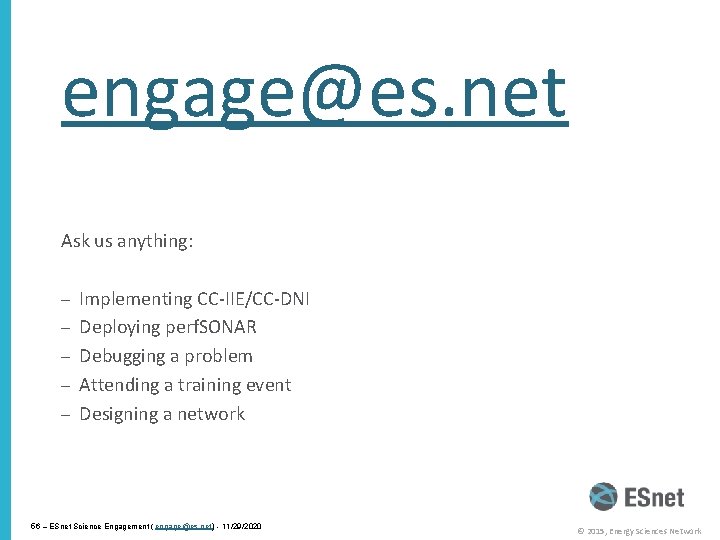

- Slides: 57

The Science DMZ: A Network Design Pattern for Data-Intensive Science Jason Zurawski – zurawski@es. net Science Engagement Engineer, ESnet Lawrence Berkeley National Laboratory ENhancing Cyber. Infrastructure by Training and Engagement (ENCITE) Webinar April 3 rd 2015

Network as Infrastructure Instrument ESnet Vision: Scientific progress will be completely unconstrained by the physical location of instruments, people, computational resources, or data. 2 – ESnet Science Engagement ( engage@es. net) - 11/29/2020 © 2015, Energy Sciences Network

Overview • Science DMZ Motivation and Introduction • Science DMZ Architecture • Network Monitoring • Data Transfer Nodes & Applications • Science DMZ Security • User Engagement • Wrap Up 3 – ESnet Science Engagement ( engage@es. net) - 11/29/2020 © 2015, Energy Sciences Network

Motivation • Science & Research is everywhere – Size of school/endowment does not matter – there is a researcher at your facility right now that is attempting to use the network for a research activity • Networks are an essential part of data-intensive science – Connect data sources to data analysis – Connect collaborators to each other – Enable machine-consumable interfaces to data and analysis resources (e. g. portals), automation, scale • Performance is critical – Exponential data growth – Constant human factors (timelines for analysis, remote users) – Data movement and analysis must keep up • Effective use of wide area (long-haul) networks by scientists has historically been difficult (the “Wizard Gap”) 4 – ESnet Science Engagement ( engage@es. net) - 11/29/2020 © 2015, Energy Sciences Network

Big Science Now Comes in Small Packages … …and is happening on your campus. Guaranteed. 5 – ESnet Science Engagement ( engage@es. net) - 11/29/2020 © 2015, Energy Sciences Network

Understanding Data Trends 6 – ESnet Science Engagement ( engage@es. net) - 11/29/2020 © 2015, Energy Sciences Network

Data Mobility in a Given Time Interval (Theoretical) These tables available: http: //fasterdata. es. net/fasterdata-home/requirements-and-expectations/ 7 – ESnet Science Engagement ( engage@es. net) - 11/29/2020 © 2015, Energy Sciences Network

The Central Role of the Network • The very structure of modern science assumes science networks exist: high performance, feature rich, global scope • What is “The Network” anyway? – “The Network” is the set of devices and applications involved in the use of a remote resource • This is not about supercomputer interconnects • This is about data flow from experiment to analysis, between facilities, etc. – User interfaces for “The Network” – portal, data transfer tool, workflow engine – Therefore, servers and applications must also be considered • What is important? Ordered list: 1. 2. 3. Correctness Consistency Performance 8 – ESnet Science Engagement ( engage@es. net) - 11/29/2020 © 2015, Energy Sciences Network

TCP – Ubiquitous and Fragile • Networks provide connectivity between hosts – how do hosts see the network? – From an application’s perspective, the interface to “the other end” is a socket – Communication is between applications – mostly over TCP • TCP – the fragile workhorse – TCP is (for very good reasons) timid – packet loss is interpreted as congestion – Packet loss in conjunction with latency is a performance killer • We can address the first, science hasn’t fixed the 2 nd (yet) – Like it or not, TCP is used for the vast majority of data transfer applications (more than 95% of ESnet traffic is TCP) 9 – ESnet Science Engagement ( engage@es. net) - 11/29/2020 © 2015, Energy Sciences Network

A small amount of packet loss makes a huge difference in TCP performance Local (LAN) Metro Area With loss, high performance beyond metro distances is essentially impossible International Regional Continental Measured (TCP Reno) Measured (HTCP) 10 – ESnet Science Engagement ( engage@es. net) - 11/29/2020 Theoretical (TCP Reno) Measured (no loss) © 2015, Energy Sciences Network

Lets Talk Performance … "In any large system, there is always something broken. ” Jon Postel • Modern networks are occasionally designed to be one-size-fits-most • e. g. if you have ever heard the phrase “converged network”, the design is to facilitate CIA (Confidentiality, Integrity, Availability) – This is not bad for protecting the HVAC system from hackers. • Causes of friction/packet loss: – Small buffers on the network gear and hosts – Incorrect application choice – Packet disruption caused by overzealous security – Congestion from herds of mice • It all starts with knowing your users, and knowing your network 11 – ESnet Science Engagement ( engage@es. net) - 11/29/2020 © 2015, Energy Sciences Network

Putting A Solution Together • Effective support for TCP-based data transfer – Design for correct, consistent, highperformance operation – Design for ease of troubleshooting • Easy adoption (for all stakeholders) is critical – Large laboratories and universities have extensive IT deployments – Small universities/facilities have overworked/understaffed IT departments – Drastic change is prohibitively difficult • Cybersecurity – defensible without compromising performance • Borrow ideas from traditional network security – Traditional DMZ • Separate enclave at network perimeter (“Demilitarized Zone”) • Specific location for external-facing services • Clean separation from internal network – Do the same thing for science – Science DMZ 12 – ESnet Science Engagement ( engage@es. net) - 11/29/2020 © 2015, Energy Sciences Network

The Science DMZ Superfecta Engagement • • • Partnerships Education & Consulting Resources & Knowledgebase Engagement with Network Users Data Transfer Node • • • High performance Configured for data transfer Proper tools perf. SONAR Performance Testing & Measurement Dedicated Systems for Data Transfer • • • Enables fault isolation Verify correct operation Widely deployed in ESnet and other networks, as well as sites and facilities Network Architecture Science DMZ • • • 13 – ESnet Science Engagement ( engage@es. net) - 11/29/2020 Dedicated location for DTN Proper security Easy to deploy - no need to redesign the whole network © 2015, Energy Sciences Network

Overview • Science DMZ Motivation and Introduction • Science DMZ Architecture • Network Monitoring • Data Transfer Nodes & Applications • Science DMZ Security • User Engagement • Wrap Up 14 – ESnet Science Engagement ( engage@es. net) - 11/29/2020 © 2015, Energy Sciences Network

Science DMZ Takes Many Forms • There a lot of ways to combine these things – it all depends on what you need to do – Small installation for a project or two – Facility inside a larger institution – Institutional capability serving multiple departments/divisions – Science capability that consumes a majority of the infrastructure • Some of these are straightforward, others are less obvious • Key point of concentration: eliminate sources of packet loss / packet friction 15 – ESnet Science Engagement ( engage@es. net) - 11/29/2020 © 2015, Energy Sciences Network

Legacy Method: Ad Hoc DTN Deployment • This is often what gets tried first • Data transfer node deployed where the owner has space – This is often the easiest thing to do at the time – Straightforward to turn on, hard to achieve performance • If lucky, perf. SONAR is at the border – This is a good start – Need a second one next to the DTN • Entire LAN path has to be sized for data flows (is yours? ) • Entire LAN path becomes part of any troubleshooting exercise • This usually fails to provide the necessary performance. 16 – ESnet Science Engagement ( engage@es. net) - 11/29/2020 © 2015, Energy Sciences Network

Ad Hoc DTN Deployment 17 – ESnet Science Engagement ( engage@es. net) - 11/29/2020 © 2015, Energy Sciences Network

Abstract Deployment • Simplest approach : add-on to existing network infrastructure – All that is required is a port on the border router – Small footprint, pre-production commitment • Easy to experiment with components and technologies – DTN prototyping – perf. SONAR testing • Limited scope makes security policy exceptions easy – Only allow traffic from partners (use ACLs) – Add-on to production infrastructure – lower risk – Identify applications that are running (e. g. the DTN is not a general purpose machine – it does data transfer, and data transfer only) • Start with a single user/user case. If it works for them in a pilot, you can expand 18 – ESnet Science Engagement ( engage@es. net) - 11/29/2020 © 2015, Energy Sciences Network

Local And Wide Area Data Flows 19 – ESnet Science Engagement ( engage@es. net) - 11/29/2020 © 2015, Energy Sciences Network

Large Facility Deployment • High-performance networking is assumed in this environment – Data flows between systems, between systems and storage, wide area, etc. – Global filesystem (GPFS, Luster, etc. ) often ties resources together • Portions of this may not run over Ethernet (e. g. IB) • Implications for Data Transfer Nodes – these are ‘gateways’ really • “Science DMZ” may not look like a discrete entity here – By the time you get through interconnecting all the resources, you end up with most of the network in the Science DMZ – This is as it should be – the point is appropriate deployment of tools, configuration, policy control, etc. – Can still employee security techniques to limit access (e. g. a bastion host to control logins) • Office networks can look like an afterthought, but they aren’t – Deployed with appropriate security controls – Office infrastructure need not be sized for science traffic 20 – ESnet Science Engagement ( engage@es. net) - 11/29/2020 © 2015, Energy Sciences Network

Large Facility (HPC, etc. ) 21 – ESnet Science Engagement ( engage@es. net) - 11/29/2020 © 2015, Energy Sciences Network

Non-R 1 Campus • This paradigm is not just for the big guys – there is a lot of value for smaller institutions with a smaller number of users • Can be constructed with existing hardware, or small additions – Does not need to be 100 G, or even 10 G. Capacity doesn’t matter – we want to eliminate friction and packet loss – The best way to do this is to isolate the important traffic from the enterprise • Can be scoped to either the expected data volume of the science, or the availability of external facing resources (e. g. if your pipe to GPN is small – you don’t want a single user monopolizing it) • Factors: – Are you comfortable with Layer 2 Networking? – How rich is your cable/fiber plant? – Can you create a dedicated facility for science? 22 – ESnet Science Engagement ( engage@es. net) - 11/29/2020 © 2015, Energy Sciences Network

Non-R 1 Campus Fiber Rich Environment 23 – ESnet Science Engagement ( engage@es. net) - 11/29/2020 © 2015, Energy Sciences Network

Non-R 1 Campus Layer 2 Switching 24 – ESnet Science Engagement ( engage@es. net) - 11/29/2020 © 2015, Energy Sciences Network

Non-R 1 Campus Single Facility 25 – ESnet Science Engagement ( engage@es. net) - 11/29/2020 © 2015, Energy Sciences Network

Non-R 1 Campus • Every campus will be different – If you are not fiber rich, other choices may be needed. – If the researchers don’t want to move to a dedicated facility, your options are also limited – Have discussions – lay out what is possible and what is not • ROI Statements: – Eliminate congestion where you can – the network path for the science user does not traverse the core -> better performance for her, and everyone else – Improve the process of science – the next time they go for an NSF/DOE/NIST grant, they can say (with confidence) the network does what they need it to do – Encourage others that are suffering in silence to seek you out. Once you have a success story, there will be others asking about it. 26 – ESnet Science Engagement ( engage@es. net) - 11/29/2020 © 2015, Energy Sciences Network

Common Threads • Two common threads exist in all these examples • Accommodation of TCP – Wide area portion of data transfers traverses purpose-built path – High performance devices that don’t drop packets • Ability to test and verify – When problems arise (and they always will), they can be solved if the infrastructure is built correctly – Small device count makes it easier to find issues – Multiple test and measurement hosts provide multiple views of the data path • perf. SONAR nodes at the site and in the WAN • perf. SONAR nodes at the remote site 27 – ESnet Science Engagement ( engage@es. net) - 11/29/2020 © 2015, Energy Sciences Network

Overview • Science DMZ Motivation and Introduction • Science DMZ Architecture • Network Monitoring • Data Transfer Nodes & Applications • Science DMZ Security • User Engagement • Wrap Up 28 – ESnet Science Engagement ( engage@es. net) - 11/29/2020 © 2015, Energy Sciences Network

Performance Monitoring • Everything may function perfectly when it is deployed • Eventually something is going to break – Networks and systems are complex – Bugs, mistakes, … – Sometimes things just break – this is why we buy support contracts • Must be able to find and fix problems when they occur (even if they have been that way for a long time) • Must be able to find problems in other networks (your network may be fine, but someone else’s problem can impact your users) • TCP was intentionally designed to hide all transmission errors from the user: – “As long as the TCPs continue to function properly and the internet system does not become completely partitioned, no transmission errors will affect the users. ” (From RFC 793, 1981) 29 – ESnet Science Engagement ( engage@es. net) - 11/29/2020 © 2015, Energy Sciences Network

Soft Network Failures – Hidden Problems • Hard failures are well-understood – Link down, system crash, software crash – Traditional network/system monitoring tools designed to quickly find hard failures • Soft failures result in degraded capability – Connectivity exists – Performance impacted – Typically something in the path is functioning, but not well • Soft failures are hard to detect with traditional methods – No obvious single event – Sometimes no indication at all of any errors • Independent testing is the only way to reliably find soft failures 30 – ESnet Science Engagement ( engage@es. net) - 11/29/2020 © 2015, Energy Sciences Network

Sample Soft Failures • Peering moved from 10 G link to 100 G link • Latency change shows path change • Performance increases • Performance stabilizes Experiments with host tuning (parallels DTN performance) 31 – ESnet Science Engagement ( engage@es. net) - 11/29/2020 © 2015, Energy Sciences Network

Testing Infrastructure – perf. SONAR • perf. SONAR is: – A widely-deployed test and measurement infrastructure • ESnet, Internet 2, US regional networks, international networks • Laboratories, supercomputer centers, universities – A suite of test and measurement tools – A collaboration that builds and maintains the toolkit • By installing perf. SONAR, a site can leverage over 1300 test servers deployed around the world • perf. SONAR is ideal for finding soft failures – Alert to existence of problems – Fault isolation – Verification of correct operation • Open Source, widely supported by a number of stakeholder organizations 32 – ESnet Science Engagement ( engage@es. net) - 11/29/2020 © 2015, Energy Sciences Network

Lookup Service Directory Search: http: //stats. es. net/Services. Directory/ 33 – ESnet Science Engagement ( engage@es. net) - 11/29/2020 © 2015, Energy Sciences Network

perf. SONAR Dashboard: http: //psdashboard. es. net 34 – ESnet Science Engagement ( engage@es. net) - 11/29/2020 © 2015, Energy Sciences Network

Overview • Science DMZ Motivation and Introduction • Science DMZ Architecture • Network Monitoring • Data Transfer Nodes & Applications • Science DMZ Security • User Engagement • Wrap Up 35 – ESnet Science Engagement ( engage@es. net) - 11/29/2020 © 2015, Energy Sciences Network

Dedicated Systems – Data Transfer Node • The DTN is dedicated to data transfer • Set up specifically for high-performance data movement – System internals (BIOS, firmware, interrupts, etc. ) – Network stack – Storage (global filesystem, Fibrechannel, local RAID, etc. ) – High performance tools – No extraneous software • Limitation of scope and function is powerful – No conflicts with configuration for other tasks – Small application set makes cybersecurity easier 36 – ESnet Science Engagement ( engage@es. net) - 11/29/2020 © 2015, Energy Sciences Network

Data Transfer Tool Comparison • In addition to the network, using the right data transfer tool is critical • Data transfer test from Berkeley, CA to Argonne, IL (near Chicago). RTT = 53 ms, network capacity = 10 Gbps. Tool Throughput scp: 140 Mbps HPN patched scp: 1. 2 Gbps ftp 1. 4 Gbps Grid. FTP, 4 streams 5. 4 Gbps Grid. FTP, 8 streams 6. 6 Gbps Note that to get more than 1 Gbps (125 MB/s) disk to disk requires properly engineered storage (RAID, parallel filesystem, etc. ) 37 – ESnet Science Engagement ( engage@es. net) - 11/29/2020 © 2015, Energy Sciences Network

Overview • Science DMZ Motivation and Introduction • Science DMZ Architecture • Network Monitoring • Data Transfer Nodes & Applications • Science DMZ Security • User Engagement • Wrap Up 38 – ESnet Science Engagement ( engage@es. net) - 11/29/2020 © 2015, Energy Sciences Network

Science DMZ Security • Goal – disentangle security policy and enforcement for science flows from security for business systems • Rationale – Science data traffic is simple from a security perspective – Narrow application set on Science DMZ • Data transfer, data streaming packages • No printers, document readers, web browsers, building control systems, financial databases, staff desktops, etc. – Security controls that are typically implemented to protect business resources often cause performance problems • Separation allows each to be optimized 39 – ESnet Science Engagement ( engage@es. net) - 11/29/2020 © 2015, Energy Sciences Network

Performance Is A Core Requirement • Core information security principles – Confidentiality, Integrity, Availability (CIA) – Often, CIA and risk mitigation result in poor performance • In data-intensive science, performance is an additional core mission requirement: CIA PICA – CIA principles are important, but if performance is compromised the science mission fails – Not about “how much” security you have, but how the security is implemented – Need a way to appropriately secure systems without performance compromises • Collaboration Within The Organization – All parties (users, operators, security, administration) needs to sign off up this idea – revolutionary vs. evolutionary change. – Make sure everyone understands the ROI potential. 40 – ESnet Science Engagement ( engage@es. net) - 11/29/2020 © 2015, Energy Sciences Network

Security Without Firewalls • Data intensive science traffic interacts poorly with firewalls • Does this mean we ignore security? NO! – We must protect our systems – We just need to find a way to do security that does not prevent us from getting the science done • Key point – security policies and mechanisms that protect the Science DMZ should be implemented so that they do not compromise performance • Traffic permitted by policy should not experience performance impact as a result of the application of policy 41 – ESnet Science Engagement ( engage@es. net) - 11/29/2020 © 2015, Energy Sciences Network

Firewall Performance Example • Observed performance, via perf. SONAR, through a firewall: Almost 20 times slower through the firewall • Observed performance, via perf. SONAR, bypassing firewall: Huge improvement without the firewall 42 – ESnet Science Engagement ( engage@es. net) - 11/29/2020 © 2015, Energy Sciences Network

“Why Does it Do That? ” • Consider a network between three buildings – A, B, and C • This is supposedly a 10 Gbps network end to end (look at the links on the buildings) • Building A houses the border router – not much goes on there except the external connectivity • Lots of work happens in building B – so much so that the processing is done with multiple processors to spread the load in an affordable way, and aggregate the results after • Building C is where we branch out to other buildings • Every link between buildings is 10 Gbps – this is a 10 Gbps network, right? ? ? 43 – ESnet Science Engagement ( engage@es. net) - 11/29/2020 © 2015, Energy Sciences Network

Clearly Not A 10 Gbps Network • If you look at the inside of Building B, it is obvious from a network engineering perspective that this is not a 10 Gbps network – Clearly the maximum per-flow data rate is 1 Gbps, not 10 Gbps – However, if you convert the buildings into network elements while keeping their internals intact, you get routers and firewalls – What firewall did the organization buy? What’s inside it? – Those little 1 G “switches” are firewall processors • This parallel firewall architecture has been in use for years – Slower processors are cheaper – Typically fine for a commodity traffic load – Therefore, this design is cost competitive and common • This mangles TCP (see results from perf. SONAR). – Packets are forced out of order – Delay occurs as we queue for access to a processor (even just to verify state and continue on) – Delay and ordering matter to TCP – all flows are reduced. The larger ones just feel it more 44 – ESnet Science Engagement ( engage@es. net) - 11/29/2020 © 2015, Energy Sciences Network

Notional 10 G Network Between Devices 45 – ESnet Science Engagement ( engage@es. net) - 11/29/2020 © 2015, Energy Sciences Network

What’s Inside Your Firewall? • “But wait – we don’t do this anymore!” – It is true that vendors are working toward line-rate 10 G firewalls, and some – – may even have them now 10 GE has been deployed in science environments for over 10 years Firewall internals have only recently started to catch up with the 10 G world 100 GE is being deployed now, 40 Gbps host interfaces are available now Firewalls are behind again • In general, IT shops want to get 5+ years out of a firewall purchase – This often means that the firewall is years behind the technology curve – Whatever you deploy now, that’s the hardware feature set you get – When a new science project tries to deploy data-intensive resources, they get whatever feature set was purchased several years ago 46 – ESnet Science Engagement ( engage@es. net) - 11/29/2020 © 2015, Energy Sciences Network

Overview • Science DMZ Motivation and Introduction • Science DMZ Architecture • Network Monitoring • Data Transfer Nodes & Applications • Science DMZ Security • User Engagement • Wrap Up 47 – ESnet Science Engagement ( engage@es. net) - 11/29/2020 © 2015, Energy Sciences Network

Challenges to Network Adoption • Causes of performance issues are complicated for users. • Lack of communication and collaboration between the CIO’s office and researchers on campus. • Lack of IT expertise within a science collaboration or experimental facility • User’s performance expectations are low (“The network is too slow”, “I tried it and it didn’t work”). • Cultural change is hard (“we’ve always shipped disks!”). • Scientists want to do science not IT support The Capability Gap 48 – ESnet Science Engagement ( engage@es. net) - 11/29/2020 © 2015, Energy Sciences Network

Bridging the Gap • Implementing technology is ‘easy’ in the grand scheme of assisting with science • Adoption of technology is different – Does your cosmologist care what SDN is? – Does your cosmologist want to get data from Chile each night so that they can start the next day without having to struggle with the tyranny of ineffective data movement strategies that involve airplanes and white/brown trucks? 49 – ESnet Science Engagement ( engage@es. net) - 11/29/2020 © 2015, Energy Sciences Network

The Golden Spike • We don’t want Scientists to have to build their own networks • Engineers don’t have to understand what a tokomak accomplishes • Meeting in the middle is the process of science engagement: – Engineering staff learning enough about the process of science to be helpful in how to adopt technology – Science staff having an open mind to better use what is out there 50 – ESnet Science Engagement ( engage@es. net) - 11/29/2020 © 2015, Energy Sciences Network

Overview • Science DMZ Motivation and Introduction • Science DMZ Architecture • Network Monitoring • Data Transfer Nodes & Applications • On the Topic of Security • User Engagement • Wrap Up 51 – ESnet Science Engagement ( engage@es. net) - 11/29/2020 © 2015, Energy Sciences Network

Why Build A Science DMZ Though? • What we know about scientific network use: – Machine size decreasing, accuracy increasing – HPC resources more widely available – and potentially distributed from where the scientists are – WAN networking speeds now at 100 G, MAN approaching, LAN as well • Value Proposition: – If scientists can’t use the network to the fullest potential due to local policy constraints or bottlenecks – they will find a way to get their done outside of what is available. • Without a Science DMZ, this stuff is all hard – “No one will use it”. Maybe today, what about tomorrow? – “We don’t have these demands currently”. Next gen technology is always a day away 52 – ESnet Science Engagement ( engage@es. net) 11/29/2020

Wrapup • The Science DMZ design pattern provides a flexible model for supporting high-performance data transfers and workflows • Key elements: – Accommodation of TCP • Sufficient bandwidth to avoid congestion • Loss-free IP service – Location – near the site perimeter if possible – Test and measurement – Dedicated systems – Appropriate security • Support for advanced capabilities (e. g. SDN) is much easier with a Science DMZ 53 – ESnet Science Engagement ( engage@es. net) - 11/29/2020 © 2015, Energy Sciences Network

The Science DMZ in 1 Slide Consists of four key components, all required: • “Friction free” network path – Highly capable network devices (wire-speed, deep queues) – Virtual circuit connectivity option – Security policy and enforcement specific to science workflows – Located at or near site perimeter if possible • Dedicated, high-performance Data Transfer Nodes (DTNs) © 2013 Wikipedia – Hardware, operating system, libraries all optimized for transfer – Includes optimized data transfer tools such as Globus Online and Grid. FTP • Performance measurement/test node – perf. SONAR • Engagement with end users Details at http: //fasterdata. es. net/science-dmz/ 54 – ESnet Science Engagement ( engage@es. net) - 11/29/2020 © 2015, Energy Sciences Network

Links – ESnet fasterdata knowledge base • http: //fasterdata. es. net/ – Science DMZ paper • http: //www. es. net/assets/pubs_presos/sc 13 sci. DMZ-final. pdf – Science DMZ email list • Send mail to sympa@lists. lbl. gov with the subject "subscribe esnetsciencedmz” – Fasterdata Events (Workshop, Webinar, etc. announcements) • Send mail to sympa@lists. lbl. gov with the subject "subscribe esnet-fasterdataevents” – perf. SONAR • http: //fasterdata. es. net/performance-testing/perfsonar/ • http: //www. perfsonar. net 55 – ESnet Science Engagement ( engage@es. net) - 11/29/2020 © 2015, Energy Sciences Network

engage@es. net Ask us anything: – Implementing CC-IIE/CC-DNI – Deploying perf. SONAR – Debugging a problem – Attending a training event – Designing a network 56 – ESnet Science Engagement ( engage@es. net) - 11/29/2020 © 2015, Energy Sciences Network

Thanks! Jason Zurawski – zurawski@es. net Science Engagement Engineer, ESnet Lawrence Berkeley National Laboratory ENhancing Cyber. Infrastructure by Training and Engagement (ENCITE) Webinar April 3 rd 2015
 Firewall stateful vs stateless
Firewall stateful vs stateless Imperva doc
Imperva doc Dmz best practices designs
Dmz best practices designs Dmz vicolo cieco
Dmz vicolo cieco Dmz betekenis
Dmz betekenis Dmž
Dmž Dmz vicolo cieco
Dmz vicolo cieco Triple-homed firewall
Triple-homed firewall Hvad er dmz
Hvad er dmz What's your favourite subject at school
What's your favourite subject at school Network design pattern
Network design pattern Network design pattern
Network design pattern Network systems design using network processors
Network systems design using network processors Fspos vägledning för kontinuitetshantering
Fspos vägledning för kontinuitetshantering Novell typiska drag
Novell typiska drag Nationell inriktning för artificiell intelligens
Nationell inriktning för artificiell intelligens Vad står k.r.å.k.a.n för
Vad står k.r.å.k.a.n för Varför kallas perioden 1918-1939 för mellankrigstiden
Varför kallas perioden 1918-1939 för mellankrigstiden En lathund för arbete med kontinuitetshantering
En lathund för arbete med kontinuitetshantering Kassaregister ideell förening
Kassaregister ideell förening Personlig tidbok
Personlig tidbok A gastrica
A gastrica Förklara densitet för barn
Förklara densitet för barn Datorkunskap för nybörjare
Datorkunskap för nybörjare Boverket ka
Boverket ka Att skriva debattartikel
Att skriva debattartikel Magnetsjukhus
Magnetsjukhus Nyckelkompetenser för livslångt lärande
Nyckelkompetenser för livslångt lärande Påbyggnader för flakfordon
Påbyggnader för flakfordon Vätsketryck formel
Vätsketryck formel Svenskt ramverk för digital samverkan
Svenskt ramverk för digital samverkan Bo bergman jag fryser om dina händer
Bo bergman jag fryser om dina händer Presentera för publik crossboss
Presentera för publik crossboss Vad är ett minoritetsspråk
Vad är ett minoritetsspråk Bat mitza
Bat mitza Treserva lathund
Treserva lathund Luftstrupen för medicinare
Luftstrupen för medicinare Bästa kameran för astrofoto
Bästa kameran för astrofoto Centrum för kunskap och säkerhet
Centrum för kunskap och säkerhet Programskede byggprocessen
Programskede byggprocessen Bra mat för unga idrottare
Bra mat för unga idrottare Verktyg för automatisering av utbetalningar
Verktyg för automatisering av utbetalningar Rutin för avvikelsehantering
Rutin för avvikelsehantering Smärtskolan kunskap för livet
Smärtskolan kunskap för livet Ministerstyre för och nackdelar
Ministerstyre för och nackdelar Tack för att ni har lyssnat
Tack för att ni har lyssnat Vad är referatmarkeringar
Vad är referatmarkeringar Redogör för vad psykologi är
Redogör för vad psykologi är Borstål, egenskaper
Borstål, egenskaper Tack för att ni har lyssnat
Tack för att ni har lyssnat Borra hål för knoppar
Borra hål för knoppar Orubbliga rättigheter
Orubbliga rättigheter Formula varians
Formula varians Tack för att ni har lyssnat
Tack för att ni har lyssnat Rita perspektiv
Rita perspektiv Ledningssystem för verksamhetsinformation
Ledningssystem för verksamhetsinformation Tobinskatten för och nackdelar
Tobinskatten för och nackdelar Blomman för dagen drog
Blomman för dagen drog
